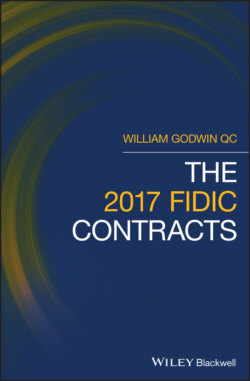Читать книгу The 2017 FIDIC Contracts - William Godwin - Страница 6
Preface
ОглавлениеIn early 2016 FIDIC asked me if I would be willing to join a new task group to write the second editions of the Red, Yellow and Silver Books. Since the first editions of the three Books were published in 1999 they have become the most widely used engineering standard form contracts internationally, and among the best regarded. It was felt nevertheless that the Books needed to be reviewed and updated to take account of developments in contracting since 1999 and to build on the substantial experience gained from use of the forms over the years. Much work had already been done by the FIDIC Contracts Committee and an earlier task group, but it remained to write the new editions with a view to publication in 2017. As a specialist lawyer I welcomed the opportunity to contribute to the writing of the new contracts and felt honoured to have been asked.
I could not have been in better company. My colleagues on the task group were all highly experienced engineers and FIDIC experts: they were Simon Worley, who became our group leader, Siobhan Fahey, Contracts Committee liaison, John Greenhalgh, Leo Grutters, Aisha Nadar and, assisting throughout as secretary to the group, Shelley Adams. I would like to pay tribute to them all. I would also like to acknowledge with gratitude the close involvement throughout of William Howard, president‐elect of FIDIC and the Executive Committee's primary liaison, and Zoltan Zahonyi, chair of the Contracts Committee.
Our task group reported to the Contracts Committee and we carried out our work under its general direction. At the London Users' Conference in December 2016 a pre‐release version of the Yellow Book was circulated and received extensive comment. This was carefully considered in preparing the eventual second editions of the three Books, along with comments and suggestions received as part of a wider consultation or friendly review by a long list of interested persons and organisations. Each of the Books was subject to a legal review before approval by the Executive Committee prior to eventual publication in December 2017.
The reaction to the new Books has been broadly positive, although they have been said to be too prescriptive and complex. To some extent this criticism was inevitable. One of the main aims of the new editions was to increase clarity and certainty so that the parties and the Engineer or Employer's Representative know exactly what is expected of them and when; another was improved project management and dispute avoidance. Fulfilling these aims was always likely to result in more prescription and complexity, but whether the right balance has been struck will be for users of the contracts to decide.
An important development since publication of the new forms has been the adoption by the World Bank of the 2017 contracts, with complementary special provisions. At the London Users' Conference in December 2018, one year after the new Books were rolled out, the World Bank revealed its intention to move away from using the Multilateral Development Banks version of the Red Book (the ‘Pink Book’) in favour of the 2017 Red Book with special provisions to cover areas of particular concern, such as the environment and social and anti‐corruption matters; the Bank indicated it would do likewise with the 2017 Yellow Book. Subsequently in early 2019 the Bank entered into a licence agreement with FIDIC permitting it to use the 2017 suite with its own conditions of particular application. FIDIC expects to enter into similar agreements with other development banks.
The aim of this book is to provide a clear and comprehensive guide to each of the 2017 FIDIC Books. After providing an overview the contracts will be examined clause by clause with the aim of showing how each Book compares and contrasts with the others and how the second editions compare and contrast with the first editions. Understanding the new contracts depends on seeing how they have developed from the first editions as well as how they relate to each other. There are also important points of intersection with the 2008 Gold Book, the FIDIC Design‐Build‐Operate form.
The first chapter seeks to put the three Books in context by indicating the extent to which they evolved from earlier forms and the distinctive characteristics of each, before providing an overview of the updates, including new potential risks for both Employer and Contractor, and then going on to consider, in the second chapter, key general provisions such as the new rules on notices and limitation of liability. Chapter 3 examines the enhanced role of the Engineer in the Red and Yellow Books/Employer's Representative's function in the Silver including the new procedure for determinations as well as the Employer's obligations and contract administration. The Contractor's obligations are considered in Chapter 4 while Chapter 5 examines his responsibility for design in the Yellow and Silver Books. Chapters 6 to 14 deal respectively with plant, materials and workmanship and staff and labour; time‐related provisions in the three contracts including extensions of time, and the Employer's right to suspend the works; testing on and after completion and the Employer's taking over of the works; defects after taking over, acceptance of the works and unfulfilled obligations; measurement (in the Red Book), the Contract Price and payment; the new variations regime and adjustments to the Price; termination and suspension; care of the works and indemnities and Exceptional Events (previously, Force Majeure). An important feature of the new contracts is their increased emphasis on clarity in the claims process and on dispute avoidance. These topics are examined in the final two chapters, 15 and 16, which deal respectively with the new claims and dispute resolution provisions of the 2017 forms.
I would like finally to express my thanks and appreciation to Dr Paul Sayer at Wiley Blackwell for his encouragement and support, and to Dr Peter Boswell, who so encouraged my involvement with FIDIC and interest in the contracts.
